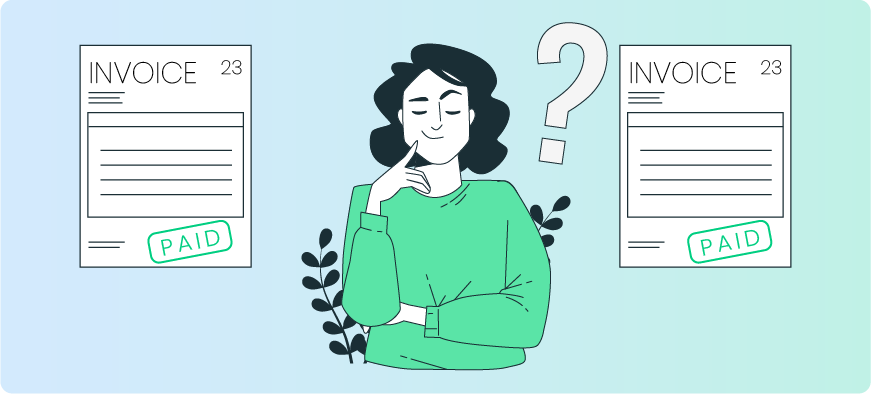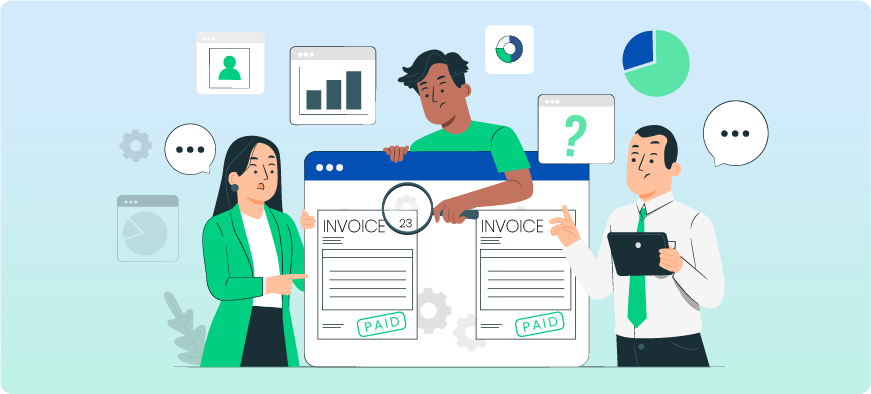Duplicate payments in accounts payable (AP) can have significant ramifications for businesses.
Not only do they result in unnecessary expenditure, but they also give rise to accounting discrepancies and potential legal complications. As such, it is crucial to proactively prevent duplicate payments. But many companies still struggle to address this issue within their AP operations, inadvertently making multiple payments for the same invoice.
With careful planning and efficient processes, it is possible to identify duplicate payments. By investing in robust AP software solutions, businesses can streamline their operations and ensure that all payments undergo proper authorization before being executed. This approach eliminates the need for manual intervention, facilitates invoice tracking, and minimizes the occurrence of duplicate payments.
What Are Duplicate Payments?
Duplicate payments are a financial error that occurs when a company pays the same invoice to a vendor more than once. This type of payment error often results from human error, such as inputting the same payment twice, or a technical glitch in payment processing systems. Even the simplest of payment errors can have a considerable impact on a business’ bottom line, particularly if it goes unnoticed for an extended period.
Over time, the cumulative effect of duplicate payments can lead to significant financial loss. Despite being a preventable issue, duplicate payments are surprisingly common in accounts payable (AP), resulting in wasted resources and potential conflicts with vendors.
Duplicate payments also lead to loss of trust among stakeholders, leading to tarnished corporate reputation, loss of business opportunities, and potential legal issues. As a result, businesses must have robust internal control procedures in place to prevent, detect, and correct duplicate payments promptly.
These procedures should include a review of all employee-initiated payments, segregation of duties, and timely reconciliation of bank statements and accounts payable transactions to ensure accurate payment processing. Failure to implement these measures and combat duplicate payments may lead to substantial financial losses and severely impact the growth and stability of any business.
Why Do Duplicate Payments Occur?

Duplicate payments in accounts payable can occur due to a variety of reasons. Here are the most common ones:
- Human Error
- Multiple Invoice Copies
- Lack of Invoice Tracking
- Insufficient Approval Processes
- Incorrect Vendor Information
- Inadequate Communication
- Delayed Posting
1) Human Error
The most common reason for duplicate payments is human error. This can happen when invoice data is manually entered more than once into the system. For instance, two different employees might enter the same invoice without realizing it, or an employee might mistakenly process the same invoice twice. In some cases, duplicate payments can also occur if there are issues with the payment processing system or software being used. Glitches or technical errors can result in duplicate transactions being processed unintentionally.
To minimize the occurrence of duplicate payments, companies can implement measures such as implementing stricter payment approval processes, conducting regular audits, and utilizing automated payment systems that have built-in checks to prevent duplicates.
2) Multiple Invoice Copies
Often, vendors send multiple copies of the same invoice via different methods like mail, email, or fax. Such occurrences are not uncommon, they happen due to miscommunication, system glitches, or human error within their organisation.
If these copies are not recognized as duplicates, they might all be processed, leading to multiple payments for the same invoice. When businesses receive multiple copies of the same invoice, there is a higher chance of accidental duplication during the payment process.
3) Lack of Invoice Tracking
If there is no effective system in place for tracking paid and unpaid invoices, it’s easy for invoices to get paid more than once. This can happen if an invoice gets misplaced and then resurfaces after it has already been paid.
Businesses that rely on manual record-keeping methods are more susceptible to duplicate payments. If invoices are stored in physical files or spreadsheets without proper organisation or tracking systems, it becomes challenging to identify whether an invoice was paid.
4) Insufficient Approval Processes
Without a proper approval process, there is a risk of paying unverified invoices. For example, an invoice could be approved and paid, and then approved and paid again if it is resubmitted.
If the approval process is not clearly defined and communicated within the organisation, there can be confusion about who has the authority to approve payments. This can lead to multiple individuals approving the same payment, resulting in duplicate transactions.
5) Incorrect Vendor Information
If there are errors in vendor details, such as having two different entries for the same vendor, it could lead to duplicate payments.
When inputting vendor information into the payment system, human error can lead to mistakes such as misspellings, incorrect account numbers, or duplicate entries. These errors can result in duplicate payments being processed. If the organisation’s vendor database is not regularly updated or maintained, there may be outdated or incomplete information. For example, if a vendor changes their bank account details and the organisation fails to update this information, payments may be sent to the wrong account, resulting in duplicate payments.
6) Inadequate Communication
If there is a lack of coordination between different teams or departments responsible for payment processing, it becomes easier for duplicate payments to slip through.
For example, if the procurement department doesn’t inform the accounting department that an invoice has already been paid, the accounting department might pay it again.
Inadequate communication can also lead to misunderstandings or misinterpretation of payment-related information. This can occur when important details, such as invoice numbers, payment amounts, or vendor details, are not clearly communicated or documented.
7) Delayed Posting
If there is a delay in posting the payment in the system after the invoice is paid, another staff member might pay the invoice again thinking it was unpaid.
Inadequate communication channels or delays in sharing relevant information can contribute to duplicate payments.
If there are no effective notification systems in place to alert individuals involved in the payment process about existing approvals or processed payments, it becomes difficult to prevent duplicate payments. Without timely notifications, individuals may inadvertently approve or process a payment that has already been completed.

Duplicate payments can cause serious problems for organisations, including:
- Financial loss: Duplicate payments result in unnecessary expenditures, leading to financial losses for the companies. These additional expenses can impact cash flow and profitability, especially if the duplicates go unnoticed for an extended period.
- Reconciliation challenges: Duplicate payments can complicate the process of reconciling accounts and financial records. Identifying and rectifying duplicate transactions requires additional time and effort, causing delays in financial reporting and potentially leading to errors in financial statements.
- Strained vendor relationships: Duplicate payments can strain relationships with vendors. Vendors may become frustrated or concerned if they receive multiple payments for the same invoice, leading to confusion and potential disputes. This can damage trust and negatively impact future business dealings.
- Operational inefficiencies: Dealing with duplicate payments diverts resources and attention away from other critical tasks. Staff members must spend time investigating and resolving the issue, which can disrupt normal workflow and productivity within the organisation.
- Audit and compliance issues: Duplicate payments can raise red flags during internal and external audits. If auditors discover a pattern of duplicate payments, it may lead to further scrutiny of the organisation’s financial controls and processes. This can result in reputational damage and potential penalties for non-compliance.
- Cash flow challenges: Duplicate payments can impact cash flow management. The organisation may face temporary cash shortages if duplicate payments are made from limited funds, affecting its ability to meet other financial obligations or invest in growth opportunities.
- Loss of credibility: Duplicate payments reflect poorly on an organisation’s financial management practices. It can erode trust among stakeholders, including investors, shareholders, and lenders, who rely on accurate and reliable financial information to make informed decisions.
How To Avoid Duplicate Payments?
To ensure the prevention of duplicate payments in accounts payable, companies can take several steps. First and foremost, it is crucial to establish a comprehensive system for effectively tracking and managing invoices. This system should encompass an up-to-date database containing all vendor information, along with a well-defined process for verifying payment details prior to authorization.
Second, implementing internal controls is essential to avoid duplicate payments. One approach is to require dual review and approval of each payment before processing. Alternatively, companies can employ specialized software programs that automatically detect duplicate invoices. Additionally, it is imperative to ensure accurate financial reporting by diligently recording all authorized payments in the company’s financial records.
It is advisable for companies to adopt procedures for promptly identifying and resolving any potential errors or discrepancies. Regular audits and reviews of the AP system can help in this regard. Any suspicious patterns or inconsistencies that may indicate duplicate payments should be promptly addressed.
Here are the main strategies how to avoid duplicate payments:

Establish a consistent method for processing invoices. You should include a standardized format for entering vendor names and invoice numbers to avoid confusion or errors.

Use a 3-way match system, which involves comparing the invoice with the purchase order and the goods receipt note before making a payment. This can help verify the accuracy of the invoice and prevent duplicate payments.

Accounts payable (AP) automation tools can help detect duplicate invoices. These tools can cross-check new invoices against previous ones in the system and flag potential duplicates for review. For example, DOKKA automatically identifies duplicate invoices, which significantly reduces the risk of duplicate payments.

If your business has multiple departments making payments, consider centralizing the accounts payable function. It can reduce confusion and ensure that all invoices are processed in the same way.

Conduct regular audits of your accounts payable. Regular audits can help identify any mistakes or inefficiencies in your process, including duplicate payments.

Maintain open lines of communication with your vendors. Encourage them to notify you of any missing payments or discrepancies, which could indicate a duplicate payment.

Make sure your AP team is well-trained and understands the importance of preventing duplicate payments. Regular training and updates can help keep everyone on the same page.

This includes segregation of duties (different people responsible for different stages of the payment process) and approval processes for payments. These controls can help prevent fraud and errors, including duplicate payments.
With the right tools and processes in place, businesses can make sure their accounts payable system remains accurate and efficient. By taking a proactive approach and implementing the proper policies and procedures, companies can save money and minimize the risk of double payments from occurring in the future.








